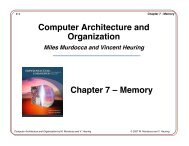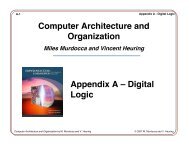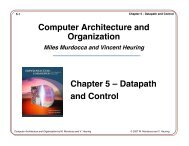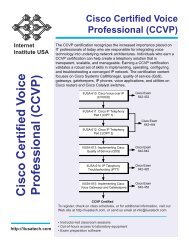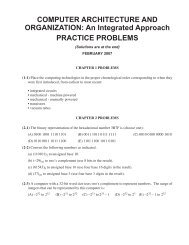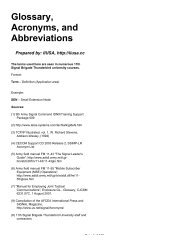Chapter 4: The Instruction Set Architecture - 10/31/2013 02:13:31 ...
Chapter 4: The Instruction Set Architecture - 10/31/2013 02:13:31 ...
Chapter 4: The Instruction Set Architecture - 10/31/2013 02:13:31 ...
Create successful ePaper yourself
Turn your PDF publications into a flip-book with our unique Google optimized e-Paper software.
4-19<br />
<strong>Chapter</strong> 4: <strong>The</strong> <strong>Instruction</strong> <strong>Set</strong> <strong>Architecture</strong><br />
One, Two, Three-Address Machines<br />
• Consider how the C expression A = B*C + D might be evaluated by<br />
each of the one, two, and three-address instruction types.<br />
• Assumptions: Addresses and data words are two bytes in size.<br />
Opcodes are 1 byte in size. Operands are moved to and from<br />
memory one word (two bytes) at a time.<br />
• Three-Address <strong>Instruction</strong>s: In a three-address instruction, the expression<br />
A = B*C + D might be coded as:<br />
mult<br />
add<br />
B, C, A<br />
D, A, A<br />
which means multiply B by C and store the result at A. (<strong>The</strong> mult<br />
and add operations are generic; they are not ARC instructions.)<br />
<strong>The</strong>n, add D to A and store the result at address A. <strong>The</strong> program<br />
size is 7×2 = 14 bytes. Memory traffic is 16 + 2×(2×3) = 28 bytes.<br />
Principles of Computer <strong>Architecture</strong> by M. Murdocca and V. Heuring<br />
© 1999 M. Murdocca and V. Heuring



